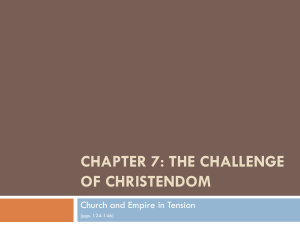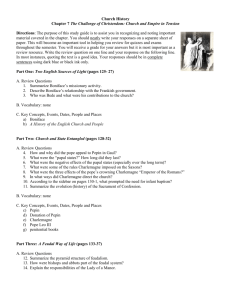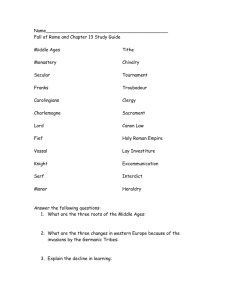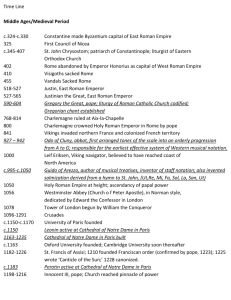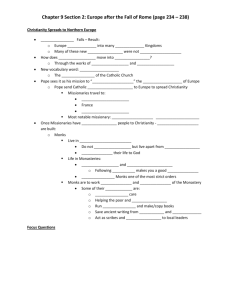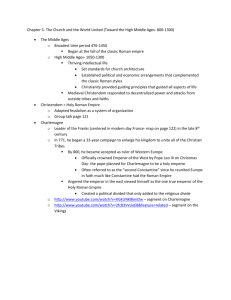Open article in new browser window
advertisement
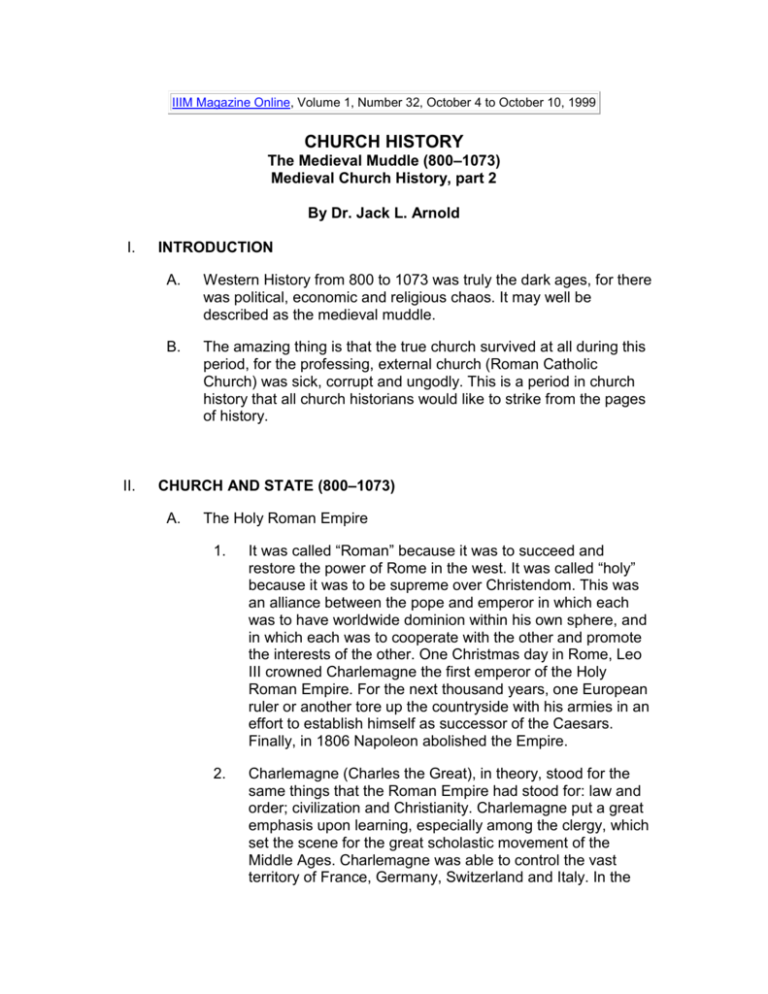
IIIM Magazine Online, Volume 1, Number 32, October 4 to October 10, 1999 CHURCH HISTORY The Medieval Muddle (800–1073) Medieval Church History, part 2 By Dr. Jack L. Arnold I. II. INTRODUCTION A. Western History from 800 to 1073 was truly the dark ages, for there was political, economic and religious chaos. It may well be described as the medieval muddle. B. The amazing thing is that the true church survived at all during this period, for the professing, external church (Roman Catholic Church) was sick, corrupt and ungodly. This is a period in church history that all church historians would like to strike from the pages of history. CHURCH AND STATE (800–1073) A. The Holy Roman Empire 1. It was called “Roman” because it was to succeed and restore the power of Rome in the west. It was called “holy” because it was to be supreme over Christendom. This was an alliance between the pope and emperor in which each was to have worldwide dominion within his own sphere, and in which each was to cooperate with the other and promote the interests of the other. One Christmas day in Rome, Leo III crowned Charlemagne the first emperor of the Holy Roman Empire. For the next thousand years, one European ruler or another tore up the countryside with his armies in an effort to establish himself as successor of the Caesars. Finally, in 1806 Napoleon abolished the Empire. 2. Charlemagne (Charles the Great), in theory, stood for the same things that the Roman Empire had stood for: law and order; civilization and Christianity. Charlemagne put a great emphasis upon learning, especially among the clergy, which set the scene for the great scholastic movement of the Middle Ages. Charlemagne was able to control the vast territory of France, Germany, Switzerland and Italy. In the days of Charlemagne, the alliance worked well, but he was always careful to maintain his position as emperor over the pope as well as over everyone else. At his death, his kingdom was divided among his three sons who were not capable rulers. The popes were able to be their own masters, and lands around Rome that had been ruled by the emperor fell into the hands of the popes. B. C. The Feudal System 1. Charlemagne had created some order out of chaos, but his death brought a progressive deterioration that was worse than anything known previously in western history. Out of the disorder of these times arose feudalism. 2. The Holy Roman Empire broke up into many small kingdoms, and the chief source of wealth was the land. There were no large cities and most people lived in the country. Feudalism was a system based upon a peculiar way of holding land. Kings would divide their kingdoms among leading warriors, on the condition that these warriors give military aid to the kings whenever called upon to do so. These princes then would divide their portions of the kingdom to lesser nobles. These nobles in turn granted sections of land to still lesser tenants, and so on down. In the feudal system one was a lord or a vassal. Lords were under obligation to give protection to their vassals, and vassals were obliged to give service, especially in war, to their lords. Feudalism was in effect a system of mutual aid. NOTE: In this system power was decentralized, and there was no strong central government. Also, no king was ever safe, for there was always the possibility of several princes combining forces against him. 3. Sometimes people gave land to churches or monasteries. Thus, bishops or archbishops, who were the heads of churches or monasteries, became landowners. This brought the clergy into the feudal system. Kings and lords looked upon the popes, bishops and clergymen as their vassals, which resulted in serious trouble for the church. The Act of Lay Investiture D. E. 1. The feudal system brought the clergy under the power of the feudal kings and lords. These lords would appoint the clergy they wanted in their kingdoms. The lords were supporting the clergy, and thus felt they had a right to choose the clergy whose salaries they were paying. Lords, of course, would choose clergymen who would support them. Thus, investiture was political, not religious, and led to corruption. Lay investiture was the specific practice of appointing laymen to clerical posts. By lay investiture, men who were not already clergy were appointed to offices in the church, sometimes to very important offices. 2. The investiture system produced chaos and anarchy in Italy. The princes were constantly at war with one another. Whenever a noble family would gain control, it would appoint its own clergy and could affect the appointment of the pope. The church was in bondage to secular rulers. Between the death of Stephen VI in 891 and the accession of John XII in 955, there were no less than twenty popes. The Practice of Simony 1. Simony is the sinful practice of giving or obtaining an appointment to a church office in exchange for money. This was a common practice in the Middle Ages, even in the obtaining of the office of pope. 2. In Italy the Tuscan family appointed Benedict IX pope in 1033. Benedict was only twelve years old at the time, and he turned out to be one of the worst characters ever to occupy the papal seat. The nobles of the Crescenzio family opposed Benedict and the Tuscan family, and in 1045 were able to drive Benedict from Rome. The Crescenzio family then appointed Sylvester III as pope. Soon, however, Benedict came back into power and resumed his pontificate. But Benedict grew tired of his office and sold it for one thousand pounds of silver to a man named Gregory VI. Later, Benedict refused to surrender the papal office which he had sold. There were then three men all claiming to be the pope: Benedict IX, Sylvester III and Gregory VI. What a tragic situation! The Church Extends Her Power and Territory III. 1. Despite the corruption of the papacy, the church was still able to extend her territory during the period from 800 to 1073. The influence of the Roman Catholic Church was felt in Hamburg, Norway, Iceland and Greenland in the north, and Bohemia, Hungary and Poland in the east. Meanwhile, the eastern church. was evangelizing to the north; Bulgaria was Christianized in the ninth century and Russia in the tenth. 2. The Roman Catholic Church also extended her power. With the fragmenting of Europe politically, the pope often stood a better chance of bringing princes, particularly the lesser ones, to terms. As Christianity spread, and with it the idea that salvation came only through membership in the church, the threat of excommunication was often enough to bring rulers to terms. THE CHURCH DIVIDES (1054) A. Since the fourth century, there had been a slowly developing division between the western and eastern sections of the church. The eastern church by 1000 still spoke Greek and had an oriental flavor. The western church spoke Latin and the majority of its members were Germanic people who had been recently brought out of barbarism. The bishops of Rome and Constantinople were in constant debate and controversy, each claiming to be supreme over the other. B. The reasons for the schism were all rather insignificant, but their combined weight produced a large result. The reasons for the division were: 1. The debate over images, or the inconoclastic controversy, in which the eastern church wanted all images done away with to ward off the charges of the Muslims that Christianity was polytheistic, contributed to the division. 2. The conflict over the procession of the Holy Spirit (either from the Father and the Son, or just from the Father) known as the Filioque (“and the Son”) Controversy was also instrumental in separating the two bodies. 3. There was an unwillingness on the part of the patriarch of Constantinople and the pope of Rome to be subservient to each other. C. 4. There was no sharp definition of boundaries of territories to be ruled by Rome and Constantinople, and frequent struggles arose over administration of border areas. 5. There were basic differences in cultural background and influence between East and West — differences which hindered understanding and cooperation. 6. The East was subservient to the emperor while the West insisted on independence from the state and the right of moral superintendence of rulers of state. Finally, in 1054 a Roman delegation laid the bull of excommunication on the altar of St. Sophia in Constantinople. Of course the Greek patriarch retaliated in kind. Thus the schism was complete. Often Roman Catholics speak of the one, universal church of Rome until the Reformation when the reformers broke from the church but, this is a misnomer. The first division of the church came in 1054, and in many ways it was much more serious than the break that came in the Reformation.

